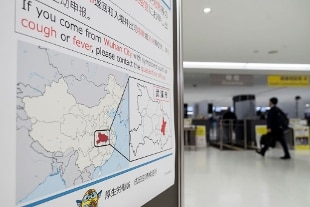- Mysterious virus in China: 17 more cases in Wuhan, 3 are serious
- Coronavirus, alert at airports around the world for the mysterious Wuhan disease
- China, pneumonia patient died: infection attributed to new Sars family virus
Share
January 21, 2020 Fourth victim in China for the new, mysterious coronavirus. Health authorities confirmed the death of a fourth person in Wuhan, the capital of Hubei province, where the outbreak of the new coronavirus developed. According to reports from the Xinhua news agency, the 89-year-old man died on Sunday. So far 198 cases have been recorded, 44 of which were critically ill.
First suspect case in Australia, man in solitary confinement in Brisbane
And it is alarm for the expansion of the virus outside the borders of China. A man was placed in solitary confinement in Brisbane, Australia after experiencing symptoms similar to those caused by the coronavirus. The man had recently returned from a visit to his relatives in Wuhan, the city of China where the outbreak of the new coronavirus developed. "We have done some tests and are waiting for the results," said Queensland health manager Jeannette Young, speaking of the patient.
The virus is transmitted from man to man
The new coronavirus, of the same Sars family, which appeared in China in the city of Wuhan, which since last December has already recorded four victims and about 200 confirmed cases, is transmissible from man to man. Confirmation of the dreaded inter-human mode of transmission, already believed likely by the director of the Department of Infectious Diseases of the Higher Institute of Health Gianni Rezza, came from a renowned expert of the Chinese Government's Public Health Commission, Zhong Nanshan.
The international alert is therefore growing, a few days before the Chinese New Year, and checks have been made at the airports, including Rome Fiumicino airport with monitoring measures and information posters for travelers.
WHO convenes emergency committee
Meanwhile, the director general of the World Health Organization (WHO), Tedros Adhanom Ghebreyesus, has convened the Emergency Committee on the new coronavirus. The committee will meet on January 22 in Geneva to investigate whether the outbreak of cases "represents an international public health emergency and what recommendations should be made to deal with it". The thought inevitably goes to the Sars epidemic which, according to the World Health Organization (WHO), between 2002 and 2003 recorded 813 deaths and 8,437 infections in about thirty countries: also in this case at the basis of the respiratory infection was a coronavirus that appeared in China. Experts, however, call for caution in the similarities and urge not to create alarmism, underlining how it is now a new strain of the virus.
After several cases of 'mysterious pneumonia' reported in Wuhan last December (with a link to the Huanan Seafood market, a wholesale market for seafood and live animals), on 9 January 2020 the Chinese CDC made known in fact the identification of a new coronavirus (2019-nCoV) as an agent that caused pneumonia and the genomic sequence was made public.
To date, two cases have also been reported in Beijing and one in Shenzhen in the south, and some are also registered outside China and associated with travel: two in Thailand, one in Japan and one in South Korea. In short, the virus is circulating and according to an estimate by Imperial College London, the actual cases could be around 1,700.
Iss: "It cannot be excluded that cases may also arrive in Europe and in Italy"
"The fact that cases also occurred outside of China and the city of Wuhan, the center of the outbreak - explains Rezza - suggests that a certain transmission has occurred from Wuhan, and it is unlikely that it is attributable to the animal basin alone. , unofficial news also speak of some cases of the virus, but very limited, in people who have not visited or stayed in Wuhan. All elements that make us think of an inhuman transmission ". At this point, he warns, "it cannot be excluded that cases may also arrive in Europe and in Italy, but the important thing is to identify and isolate them immediately. If you intervene quickly you can in fact block the spread, isolating the infected and proceeding to quarantine of contacts, but it is clear - he specifies - that this can only be done if there are not many infected ". And five, in 16 years, the viruses that have made the 'jump of species', that is that from the animals that hosted them have become capable of being transmitted from man to man, notes the virologist Ilaria Capua, according to whom it is a "strong alarm bell".
As for the risk that the virus may also reach the West, "the probability of introduction of the virus into the European Union is considered low, although - says the Ministry of Health - it cannot be excluded". Italy, at Fiumicino airport, has 3 direct flights with Wuhan, and numerous non-direct flights. As required by the International Health Regulations, therefore, at Fiumicino there is a health procedure in place to check the presence of suspected symptomatic cases on board the planes from Wuhan and their possible transfer to bio-containment at the Spallanzani Institute in Rome. Information posters were also posted at the airport. For its part, the WHO encourages all countries to strengthen the surveillance of acute respiratory infections but, at the moment, does not recommend any restrictions on travel and trade.

